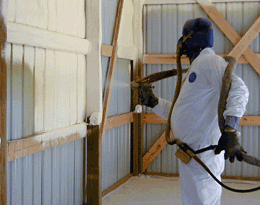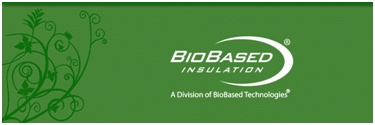“Insulation, the Past, the Present and the Future”
The History Channel’s Modern Marvels aired a segment on April 26, 2006 titled “Insulation, the Past, the Present and the Future.” The show features Spray Foam as one of “the Best Insulators Available.”
We are proud to be able to offer a foam package to fit every need and budget. For those projects that require closed cell foam we offer Bay Systems.
BaySystems NorthAmerica is the leading manufacturer of SPF spray-applied polyurethane foam roofing, insulation and advanced coating systems. We have more than 30 years of proven performance in the roofing industry, with well over one billion square feet of SPF roofing applied in a wide range of environments.
BaySystems insulation and coating systems are designed to provide durable, trouble-free performance in any climate and under any weather conditions for multiple applications, with national and regional code approvals and compliance. BaySystems is LEED Compliant, Energy Star Rated, Dade County approved while meeting or exceeding many other compliances and codes.
To learn more about Bayseal™ SPF Insulation, click here:
- Specifications
- Technical Data Sheets
- Material Safety Data Sheets
- Code Approvals
- Detail Drawings
BioBased Insulation® offers a a family of polyurethane foam products suitable for home, commercial and industrial structures. BioBased 501w®, and BioBased® 502 are open cell, semi-rigid spray foams. BioBased 1701s®, a closed cell, rigid spray foam was the first polyurethane spray foam insulation to earn GREENGUARD for Children and Schools certification. 2001NB is a non-biobased, 245fa-blown closed cell insulation.
Soy Seal® HD and Soy Seal® XD are closed cell foam sealants used for a variety of agricultural and industrial applications including sealing livestock houses, soil and rock stabilization, pipeline trench breaker, pad, pillow and poly backfill, crack and joint sealing and post and pole setting.
Product Technical Data Sheets
Open Cell
BioBased 501w® Technical Data Sheet (pdf)
BioBased 501w® Hoja de datos técnocosde (pdf)
BioBased 502® Technical Data Sheet (pdf)
BioBased 502w® Hoja de datos técnocosde (pdf)
BioBased Insulation®Open Cell Product Quick Reference (pdf)
BioBased Insulation®Referencia rápida para aislamiento de célula abierta (pdf)
Closed Cell
BioBased 1701s® Technical Data Sheet (pdf)
BioBased 1701s® Hoja de datos técnocosde (pdf)
2001NB Technical Data Sheet(pdf)
2001NB Hoja de datos técnocosde (pdf)
BioBased Insulation®Closed Cell Product Quick Reference (pdf)
BioBased Insulation®Referencia rápida para aislamiento de célula cerrada(pdf)
Sealants
Soy Seal® HD and Soy Seal® XD Technical Data Sheet (pdf)
BioBased Insulation® Sealant Product Quick Reference (pdf)
Material Safety Data Sheets -Finshed Foam
Open Cell
BioBased 501w® Finished Foam
BioBased 501w® Finished Foam (Spanish)
BioBased 502w® Finished Foam
Closed Cell
BioBased 1701s® Finished Foam
BioBased 1701s® Finished Foam (Spanish)
Sealants
Material Safety Data Sheets – A and B sides
Open Cell
BioBased 501w® B side
BioBased 502w® B side
Closed Cell
BioBased 1701s® B side
2001 NB B side
Sealants
Soy Seal® HD (white) B Side
Soy Seal® HD (black) B Side
Soy Seal® HD (neutral) B Side
Soy Seal® XD (white) B Side
Soy Seal® XD (black) B Side
Soy Seal® XD (neutral) B Side
A Side
Biobased A® Side
Biobased A® Side
Spray polyurethane foam (SPF) is an insulation innovation that provides superior performance and advanced energy efficiency. It’s so effective that thinner applications can rival and exceed the performance of traditional insulation products.
Combining two liquid components at installation creates cellular spray foam that expands and fully adheres to surfaces. The spray foam offers superior insulating properties and effective air isolation.
Spray foam insulation requires an ignition or thermal barrier after installation to comply with International Building Code requirements. All fire protective requirements detailed within Section 2603.4 of the IBC are mandatory.
No matter what climate you are building in or the level of performance required, Johns Manville has a complete line of spray foam insulation to help improve the energy efficiency, performance and comfort of a structure.
Closed-Cell Spray Foam Insulation
Closed-cell spray polyurethane foam (SPF) is one of the most advanced insulation solutions available, providing nearly twice the R-value of open-cell foam per inch. The dense polyurethane foam insulation is extremely durable, expanding and fully adhering to surfaces, strengthening the structure of a home. It provides incredible thermal performance and can be installed in areas that would be inaccessible or difficult for other forms of insulation. It effectively isolates air currents and moisture, reducing the chance of mold or mildew and increasing the life of a home.
Closed-cell spray foam requires an ignition or thermal barrier after installation to comply with International Building Code requirements. All fire protective requirements detailed within Section 2603.4 of the IBC are mandatory.
JM Corbond III® SPF
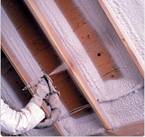
The line of TPR2 Fireshell™ intumescent coatings are recommended for application as an ignition barrier for JM Corbond III® SPF, as required by International Building Codes.
JM Corbond MCS™ SPF
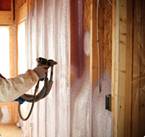
Open-Cell Spray Foam Insulation
JM Open-cell Spray Foam (JM ocSPF)
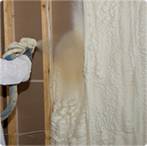
Closed Cell vs. Open Cell Foam
What is the Difference between Open-cell and Closed-cell Polyurethane Foams? This may be one of the most important pages on the website if your interest is in spray foam insulation. When it comes time to actually put the foam product in your home or commercial building structure, you must identify whether you will use .05 lb./cu. ft., open cell foam, or 2.0 lb./cu. ft. closed cell foam. This makes a big difference in cost, application methods, and performance. With the open-cell vs. closed-cell issue, there are two major factors to understand and consider. The first is the nature of the foam. It is either open-cell foam, where the tiny cells of the foam are not completely closed. They are broken and air fills all of the “open” space inside the material. This makes the foam weaker or softer feeling than closed-cell foam. Closed-cell foam differs in that all of its tiny foam cells are closed and packed together. They are filled with a gas that helps the foam rise and expand and become a greater insulator. These cells can be formulated to obtain many characteristics, the most common being size and density. Density is measured by weighing one solid cubic foot of foam material. Open cell foams typically weigh in at 0.4 to 0.5 lb./cu. ft. Closed cell foam for insulation applications range in density from 1.7 lb./cu. ft. to 2.0 lb./cu. ft. Roofing applications typically use a 2.8 to 3.0+ lb./cu. ft. to support traffic and loads better. The higher the density the foam, the heavier, or stronger it becomes. Some polyurethane foams are molded into decorative interior molding and painted or stained for a simulated wood effect. These “higher density” foams are typically in the 30 lb./cu. ft. to 40 lb./cu. ft. density range. The advantages of closed-cell foam compared to open-cell foam include its strength and higher R-value. The disadvantage of the closed-cell foam is that it is more expensive and often times needs to be covered with an ignition barrier. The choice of foam can also be based on the requirements for the other performance or application specific characteristics such as strength, vapor control, available space, etc. Open-cell SPF has an R-value around 3.5 per inch and typically uses water as the blowing agent. Closed-cell SPF has an R-value of around 6.9 per inch (aged R-value) and uses high R-value blowing agents. Both types of foam are commonly used in most building applications and the choice for which to use can depend on many of the factors discussed above. Some foams are inappropriate in specific applications. For example, you typically would not use open-cell foam below grade or in flotation applications where it could absorb water; this would negate its thermal performance because water is a poor insulator compared to air. Closed-cell foam would be a good choice where small framing sizes need the greatest R-value per inch possible.
IGNITION BARRIER VS. THERMAL BARRIER
CLEARING THE CONFUSION
One issue that has caused a lot of confusion is the requirements for Thermal and Ignition Barriers when using spray foam. There are several different interpretations to the rule but only one CORRECT set of rules to follow.
Definitions:
Ignition Barrier– A product that prevents the ignition of the product to which it is applied from spark or direct heat but does not protect from direct flame over a period of time. Most Ignition Barriers are sprayed onto the surface of the exposed Foam, however, ½” mineral wool can also be installed over the Spray Foam as the Ignition Barrier. Some examples of Ignition Barrier coatings are Bayseal IC andAldocoat 757.
Thermal Barrier– A Thermal Barrier as far as code is concerned is any product that has been ASTM tested and is considered to have a 15 minute fire protection rating also referred to as “an index of 15”. Thermal Barriers limit the temperature of the underlying Spray Polyurethane Foam to not more than 250 degrees F after 15 minutes of fire exposure. Thermal Barriers can be a spray on coating, a ½” layer of gypsum drywall, or a ¼” thick piece of plywood or particle board. Some examples of Thermal Barrier Coatings are Andek Fireguard and Flameseal TB.
When to use Thermal Barrier over spray foam:
Code requires that all Spray Polyurethane Foam that is installed in an application in which it is left exposed to living space, be covered with a 15 minute THERMAL BARRIER. Examples of this application are: Basement band Joists, Basement Walls and commercial, industrial or agricultural buildings where the foam is left exposed to the people, animals, or equipment inside. In every case the Spray Foam must be separated from the interior of a building by a 15 minute thermal barrier.
When to use Ignition Barrier:
Code requires that all spray foam that is installed in an application in which the space is used strictly for the service of utilities be covered with an IGNITION BARRIER. Examples of this application are: An attic with a hatch access, a crawl space or the back of an open knee wall.
If these spaces are used for storage of any kind, even if it is one box of holiday decorations, the requirement changes and a Thermal Barrier is needed.
All Thermal Barriers are also Ignition Barriers but not all Ignition Barriers are Thermal Barriers.



